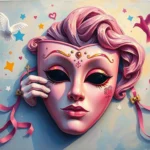
Have you ever woken up from a dream that left you feeling bewildered, moved, or even a little frightened? Dreams have a way of weaving intricate tapestries that reflect our deepest fears, desires, and unresolved conflicts. They can serve as a mirror to our subconscious, revealing truths that we may not be fully aware of in our waking lives. Exploring these hidden dreamscapes can be like embarking on a treasure hunt, where every symbol, every scenario, holds the key to understanding ourselves better.
In this article, we’ll delve into the art of dream interpretation, combining cultural perspectives, psychological insights, and practical advice. Whether you are a seasoned dreamer or someone just starting to explore the meaning behind your nightly adventures, this journey is bound to enrich your understanding of both your dreams and yourself.
The Language of Symbols: Decoding Your Dreamscape
When it comes to dreams, symbols are the language of the unconscious. Just as a painter uses colors and shapes to express emotions, our minds employ symbols to convey feelings and thoughts that may be difficult to articulate. Each symbol can have multiple meanings, influenced by culture, personal experiences, and the context of the dream itself.
For instance, let’s consider the symbol of water. In many cultures, water represents emotions and the subconscious mind. A calm lake might signify tranquility, while a turbulent sea could indicate emotional turmoil. Similarly, a house in dreams often symbolizes the self; the condition of the house can reflect your mental and emotional state. A crumbling structure might suggest feelings of instability or neglect, whereas a beautifully decorated home could indicate a sense of comfort and security.
Another powerful symbol is flight. Dreaming of soaring through the sky often signifies a desire for freedom or escape from the constraints of reality. However, if you find yourself falling instead, it may reflect feelings of insecurity or a fear of failure. Understanding these symbols can be your first step toward personal insight, allowing you to take stock of your current emotional landscape.
By keeping a dream journal, you can begin to note recurring symbols and themes. This practice not only helps you remember your dreams but also allows you to track your emotional growth over time. Reflecting on these symbols can yield profound insights into your waking life, guiding you toward self-discovery and healing.
Dreamscapes in Action: Scenarios from the Night
Dreams often unfold like vivid stories, with characters and plots that can feel incredibly real. Let’s explore a few common dream scenarios to understand how they might resonate with your waking life.
1. The Exam Dream
You find yourself unprepared for an important exam, frantically flipping through pages of your textbook, only to realize you haven’t studied any of the material. This dream often reflects feelings of anxiety, especially regarding performance and self-worth. It may suggest that you’re facing a situation in your life where you feel unprepared or fear judgment from others.
2. The Lost Journey
In this dream, you are trying to navigate a maze-like city but can’t find your way. You feel lost and anxious as you wander through unfamiliar streets. This scenario often symbolizes feelings of confusion or uncertainty in your waking life. You may be at a crossroads, unsure of which path to take, and your subconscious is reflecting that struggle.
3. The Inescapable Chase
You find yourself being chased by an unknown figure. No matter how fast you run, you can’t seem to escape. This dream is common and speaks to feelings of avoidance or fear. It may indicate problems in your waking life that you are reluctant to confront, whether that’s a difficult relationship, job stress, or personal insecurities.
4. The Naked Revelation
You suddenly realize you are in public without any clothes, feeling exposed and vulnerable. This dream taps into feelings of shame, fear of judgment, or insecurity. It may suggest that you are grappling with aspects of your identity that you are not yet ready to share with the world.
5. The Reunited Loved One
You dream of a deceased loved one, holding a heartwarming conversation or sharing a meaningful moment. This type of dream often reflects your ongoing emotional connection to that person. It can serve as a comforting reminder that love endures even beyond physical presence, and it may also provide closure or healing from past grief.
As you reflect on these scenarios, consider how they resonate with your own life experiences. Dreams can act as a guiding light, helping you navigate through complex emotions and situations when you take the time to listen to their messages.
Dreaming Forward: Cultivating Personal Growth
Understanding your dreams isn’t just about deciphering symbols or analyzing scenarios; it’s about using these insights to foster personal growth. Every dream carries the potential to teach us something valuable, if we’re willing to engage with it.
One effective way to harness the power of your dreams is to practice mindfulness. By becoming more aware of your thoughts and feelings during the day, you can create a stronger connection to your subconscious mind. Techniques like meditation and deep breathing can help you cultivate a peaceful state of mind, making it easier to reflect on your dreams without judgment or fear.
Additionally, consider setting intentions before you sleep. You might say to yourself, “I want to understand my feelings about my job” or “I seek clarity on a relationship issue.” This practice can help direct the focus of your dreams, encouraging your subconscious to address specific concerns.
Another valuable tool is creative expression. After recording your dreams, try to illustrate them through drawing, writing, or storytelling. This can deepen your understanding and allow you to process complex emotions in a tangible form. Engaging with your dreams creatively can also spark new ideas and solutions to challenges you may be facing.
Lastly, don’t hesitate to seek support from others. Sharing your dreams with trusted friends or a therapist can provide fresh perspectives and insights. Sometimes, an outside viewpoint can illuminate aspects of your dream that you might not have considered.
Remember, dreams are not just fleeting images in the night; they are a rich tapestry of your inner world. By embracing this journey of exploration, you can unlock profound truths about yourself and pave the way for personal transformation.
As you step into your night, remember this: every dream is a doorway to deeper understanding. By taking the time to engage with your dreams, you can gain clarity, foster healing, and ultimately grow into the person you are meant to be. Reflect on your dreamscapes, for within them lie the keys to your most authentic self.







